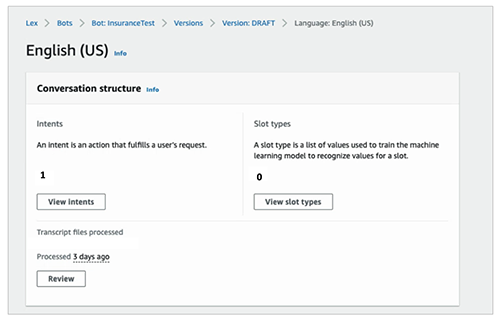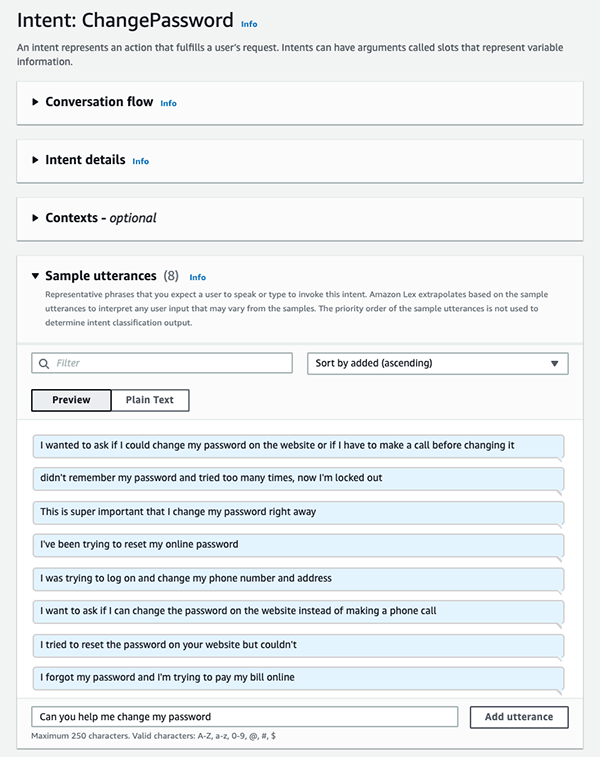Artificial Intelligence
Expedite conversation design with the automated chatbot designer in Amazon Lex
Update June 20th 2022: The Automated Chatbot Designer is now generally available. Since the preview launch, we have improved quality of intent recommendations and diversity of utterances, introduced a click-through experience, and added usability enhancements. These updates, further reduces time and effort it takes to design a chatbot.
Today, we’re launching the Amazon Lex automated chatbot designer (preview), which reduces the time and effort it takes for customers to design a chatbot by automating the process using existing conversation transcripts. Amazon Lex helps you build, test, and deploy chatbots and virtual assistants on contact center services (such as Amazon Connect), websites, and messaging channels (such as Facebook Messenger). The automated chatbot designer expands the usability of Amazon Lex to the design phase. It uses machine learning (ML) to provide an initial bot design that you can then refine and launch conversational experiences faster. With the automated chatbot designer, Amazon Lex customers and partners get an easy and intuitive way of designing chatbots and can reduce bot design time from weeks to hours.
Conversation design
Organizations are rapidly adopting chatbots to increase self-service and improve customer experience at scale. Contact center chatbots automate common user queries and free up human agents to focus on solving more complex issues. You can use Amazon Lex to build chatbots that deliver engaging user experiences and lifelike conversations. Amazon Lex provides automatic speech recognition and language understanding technologies to build effective chatbots through an easy-to-use console. But before you can build a chatbot, you have to design it. The design phase of the chatbot building process is still manual, time-consuming, and one that requires conversational design expertise.
Conversation design is the discipline of designing conversational interfaces, including the purpose, experience, and interactions. The discipline is still evolving and requires a deep understanding of spoken language and human interactions.
Creating a chatbot needs equal parts technology and business knowledge. The first step of designing a bot is conducting user research based on business needs and identifying the user requests or intents to focus on. Customers often start with analyzing transcripts of conversations between agents and users to discover and track the most frequently occurring intents. An intent signifies the key reason for customer contact or a goal the customer is trying to achieve. For example, a person contacting an insurance company to file a claim might say, “My basement is flooded, I need to start a new claim.” The intent in this case is “file a new claim.” It can take a team of business analysts, product owners, and developers multiple weeks to analyze thousands of lines of transcripts and find the right intents while designing chatbots for their contact center flows. This is time-consuming and may lead to missing intents. The second step is to remove ambiguity among intents. For example, if a user says “I want to file a claim,” it is important to distinguish if the user is trying to file a home or auto claim. The typical trial-and-error approach to identify such overlaps across intents can be error-prone. The third and final step is compiling a list of valid values of information required to fulfill different intents. For example, to fulfill the intent “file a new claim,” developers need a list of different policy types (auto, home, and travel). A chatbot with missing, incomplete, or overlapping intents will fail to resolve user requests accurately, resulting in frustrated customers.
Automated chatbot designer simplifies the design process
The automated chatbot designer builds on the simplicity and ease of use of Amazon Lex by automatically surfacing an initial bot design. It uses ML to analyze conversation transcripts between callers and agents, and semantically clusters them around the most common intents and related information. Instead of starting your design from scratch, you can use the intents surfaced by the chatbot designer, iterate on the design, and achieve your target experience faster.
In the example of an insurance chatbot, the automated chatbot designer first analyzes transcripts to identify intents such as “file a new claim” automatically from phrases, such as “My basement is flooded, I need to start a new claim” or “I want to file a roof damage claim.” The automated chatbot designer can analyze thousands of lines of transcripts within a few hours, minimizing effort and reducing chatbot design time. This helps make sure that the intents are well defined and well separated by automatically removing any overlaps between them. This way, the bot can understand the user better and avoid frustration. Finally, the automated chatbot designer compiles information, such as policy ID or claim type, needed to fulfill all identified intents.
By reducing manual effort and human error from every step of chatbot design, the automated chatbot designer helps create bots that understand user requests without confusion, improving the end user experience.
NeuraFlash, a certified Amazon Services Delivery Partner, provides a full range of professional services to companies worldwide. “We specialize in building solutions grounded in data that transform and improve the customer journey across any use case in the contact center. We often analyze large amounts of conversational data to chart the optimal conversational experience for our clients,” says Dennis Thomas, CTO at NeuraFlash. “With the automated chatbot designer, we can identify different paths in calls quickly based on the conversational data. The automated discovery accelerates our time to market across our client engagements and helps us deliver better customer experiences. We are excited to partner with AWS and help organizations transform their businesses with AI-powered experiences.”
Create a bot with the automated chatbot designer
Getting started with the automated chatbot designer is very easy. Developers can access it on the Amazon Lex console and upload transcripts to automatically create the bot design.
- On the Amazon Lex V2 console, choose Bots.
- Choose Create bot.

- Select Start with transcripts as the creation method.
- Give the bot a name (for this example,
InsuranceBot) and provide a description. - Select Create a role with basic Amazon Lex permissions and use this as your runtime role.
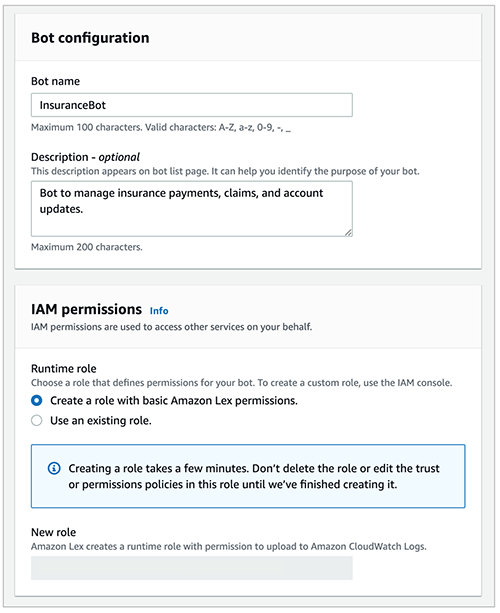
- After you fill out the other fields, choose Next to proceed to the language configuration.
As of this writing, the automated chatbot designer is only available in US English.
Next, you specify the Amazon Simple Storage Service (Amazon S3) location of the transcripts. Amazon Connect customers using Contact Lens can use the transcripts in their original format. Conversation transcripts from other transcription services may require a simple conversion.
- Choose the S3 bucket and the path where the transcripts are located.
In case of Contact Lens for Amazon Connect format, the files should be located at /Analysis/Voice. If you have redacted transcripts, you can provide /Analysis/Voice/Redacted as well. For this post, you can use the following sample transcripts. Note that fields like names and phone numbers included in these sample transcripts or in our examples are comprised of synthetic (or ‘fake’) data.
If you plan to use the sample transcripts, you will have to first upload the transcripts to an S3 bucket: Unzip the files to a local folder. Next, navigate to the S3 console, provide a bucket name, and click on Create Bucket. Once the bucket is created, click on the bucket name and click on Add Folder to provide the location of the unzipped files. Finally, click on Upload to upload the conversation transcripts.
- Choose your AWS Key Management Service (AWS KMS) key for access permissions.
- Apply a filter (date range) for your input transcripts.

- Choose Done.
You can use the status bar on the console to track the analysis. Within a few hours, the automated chatbot designer surfaces a chatbot design that includes user intents, sample phrases associated with those intents, and a list of all the information required to fulfill them. The amount of time it takes to complete training depends on several factors, including the volume of transcripts and the complexity of the conversations. Typically, 600 lines of transcript are analyzed every minute.
The Intents tab lists all the intents along with sample phrases and slots, and the Slot types tab provides a list of all the slot types along with slot type values.
You can choose any of the intents to review the sample utterances and slots. For example, in the following screenshot, we choose ChangePassword to view the utterances.
- You can click on the associated transcripts to review the conversations used to identify the intents.
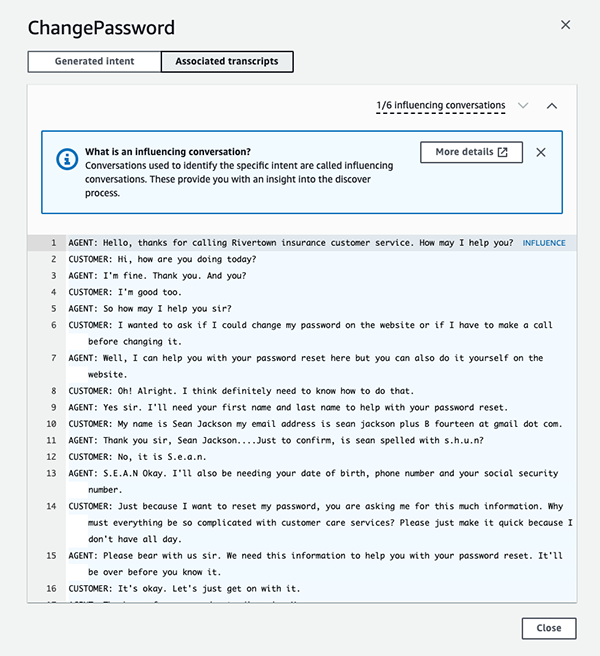
- After you review the results, you can select the intents and slot types relevant to your use case and choose Add.
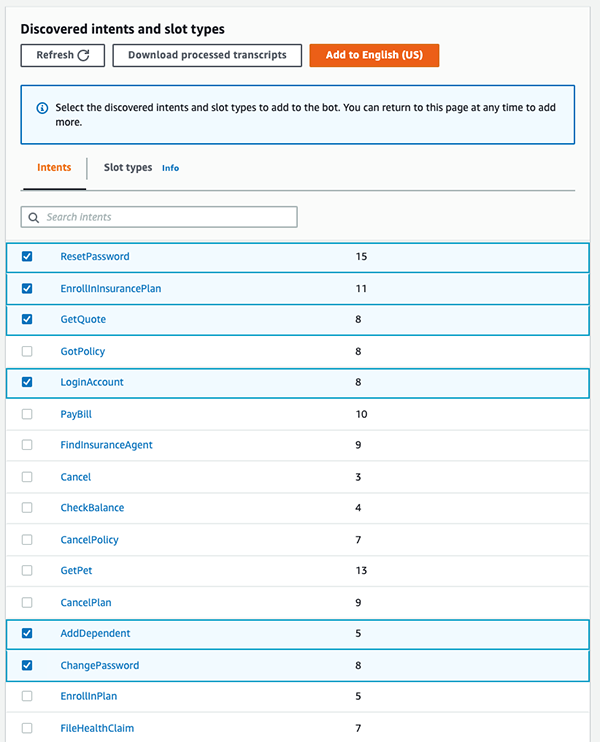
This adds the selected intents and slot types to the bot. You can now iterate on this design by making changes such as adding prompts, merging intents or slot types, and renaming slots.
In summary, the chatbot designer analyzes a conversation transcript to surface common intents, associated phrases, and information the chatbot needs to capture to resolve issues (such as customer policy number, claim type, and so on). You still have to iterate on the design to fit your business needs, add chatbot prompts and responses, integrate business logic to fulfill user requests, and then build, test, and deploy the chatbot in Amazon Lex. The automated chatbot designer automates a significant portion of the bot design, minimizing effort and reducing the overall time it takes to design a chatbot.
Things to know
The automated chatbot designer is launching today as a preview, and you can get started with it right away for free. After the preview, you pay the prices listed on the Amazon Lex pricing page. Pricing is based on the time it takes to analyze the transcripts and discover intents.
The automated chatbot designer is available on English (US) in all the AWS Regions where Amazon Lex V2 operates. With the automated chatbot designer in Amazon Lex, you can streamline the lengthy design process and create chatbots that understand customer requests and improve customer experiences. For more information, please check out our documentation here.
About the Authors
 Priyanka Tiwari is a product marketing lead for AWS data and machine learning where she focuses on educating decision makers on the impact of data, analytics, and machine learning. In her spare time, she enjoys reading and exploring the beautiful New England area with her family.
Priyanka Tiwari is a product marketing lead for AWS data and machine learning where she focuses on educating decision makers on the impact of data, analytics, and machine learning. In her spare time, she enjoys reading and exploring the beautiful New England area with her family.
 As a Product Manager on the Amazon Lex team, Harshal Pimpalkhute spends his time trying to get machines to engage (nicely) with humans.
As a Product Manager on the Amazon Lex team, Harshal Pimpalkhute spends his time trying to get machines to engage (nicely) with humans.


